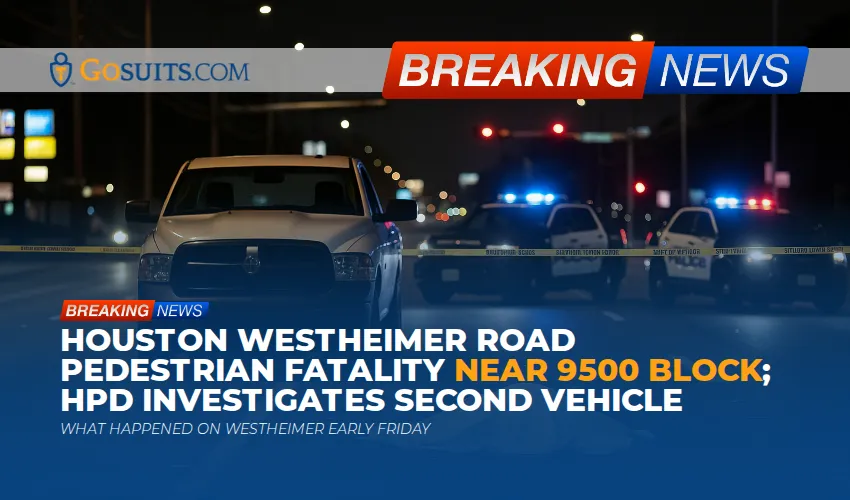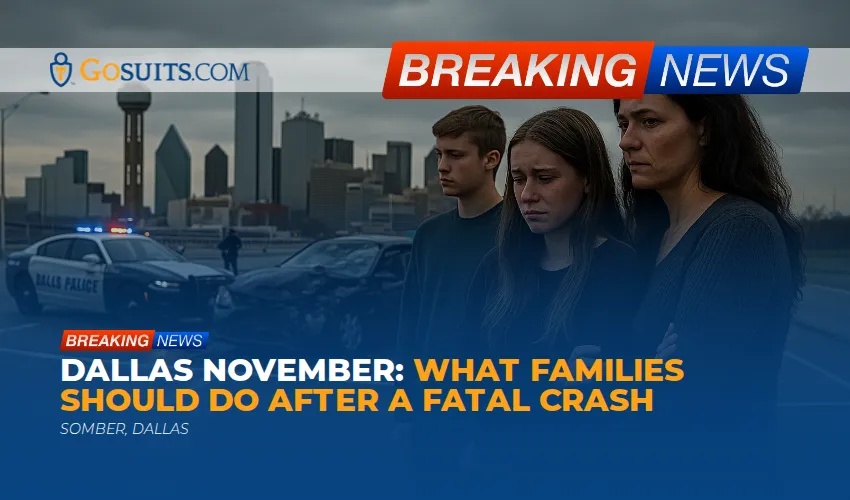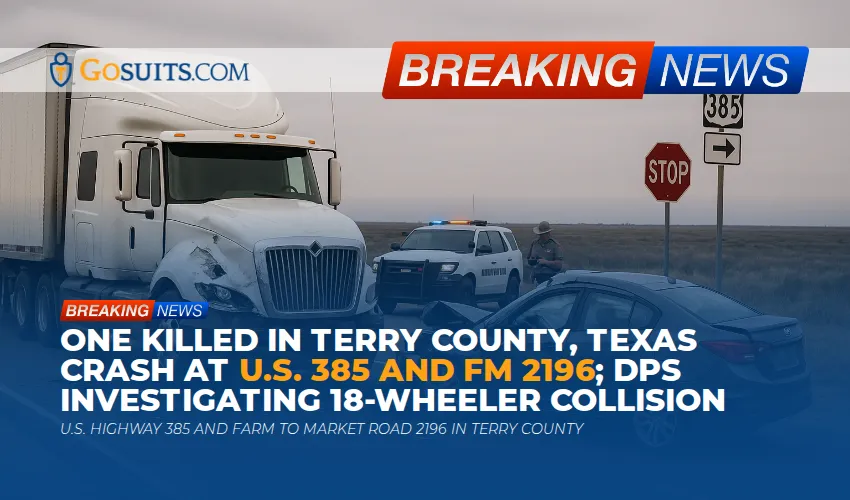- What We Know About the Highway 14 Collision in Mexia
- Location Context: North Highway 14 Near the Airport
- Essential Documents Families Commonly Need
- How to Get the Police Crash Report, Inquest/Autopsy, and Death Certificates
- Preserving Evidence After a Serious Crash
- Texas Insurance Basics After a Fatal or Serious Injury Crash
- Texas Wrongful Death and Survival Claims: The Big Picture
- Timelines and Deadlines That Can Affect a Case
- Community Considerations and Support in Limestone County
- Moving Forward With Care: Practical Steps
- Next Steps: Why Acting Now Matters
- Commentary from Gosuits Mexia, Texas Personal Injury Attorney
- Sources
What We Know About the Highway 14 Collision in Mexia
Two drivers were killed in a collision reported around 5:10 p.m. in the 4800 block of North Highway 14 on Wednesday in Mexia. According to police, officers arrived to find a crash involving two vehicles with multiple occupants. One driver was pronounced deceased at the scene. The second driver was transported and later pronounced deceased at the hospital. All other occupants from both vehicles were transported to emergency facilities for medical care. As of the latest police update, the cause of the crash is unknown and the investigation is ongoing. Officials did not release the makes and models of the vehicles or the names of those involved. No further information was available at the time of reporting.
That’s the core of what’s been confirmed. Everything else should wait for the official investigative record or reliable updates. Families and community members can expect investigators to reconstruct the collision, document roadway and vehicle evidence, and analyze any available witness statements, on-board data, and camera footage.
Location Context: North Highway 14 Near the Airport
Locals know North Highway 14 as a busy corridor that runs north-south through Mexia toward rural Limestone County. The mention of “near the airport” refers to the Mexia-Limestone County Airport area along the northern stretch of town. Around dusk, this stretch can see shifting visibility as the sky changes and headlights start to dominate. The airport area includes open approaches and cross-streets with changing traffic patterns, and it’s not uncommon to see mixed traffic: commuters, local residents, and occasional out-of-town drivers heading toward US 84 or Lake Mexia. In late fall, sunset comes early, and traffic can bunch up after the school and workday. None of that explains what happened here, and it shouldn’t be taken as a cause. It’s simply context that many in the community will recognize.
On two-lane highways like 14, minor misjudgments can have serious outcomes. National safety agencies emphasize that risk increases when speeds are higher and sightlines are limited. Rural and semi-rural roadways often lack the buffer zones or medians common in larger urban corridors. This is why investigators look at line-of-sight, braking marks, roadway edges, nearby driveways, and any signage or lighting issues alongside driver behavior and vehicle conditions.
Essential Documents Families Commonly Need
In the days after a serious crash, it can feel overwhelming to figure out what paperwork to request and from whom. The items below are the records most families eventually seek, both for closure and for insurance or civil claims.
- Official police crash report (the Texas CR-3 officer’s crash report)
- Inquest/autopsy report if one was ordered, along with the justice of the peace or medical examiner’s determinations
- Death certificate (certified copies for probate, insurance, and other administrative needs)
- EMS run sheets and hospital records for any injured survivors
- Towing and storage records including the yard location, intake photos, and release forms
- Insurance policy documents for all involved vehicles, including any available personal injury protection (PIP) or medical payments coverage, and liability limits
- Photographs or videos from the scene, if available, including nearby business or traffic cameras
Not everything is immediately available. Crash reports can take days or weeks to finalize, and inquests follow their own timeline. Keeping a simple checklist and log of requests helps families stay organized during a difficult time.
How to Get the Police Crash Report, Inquest/Autopsy, and Death Certificates
Police Crash Report (CR-3)
When a crash involves injury or death in Texas, an officer’s crash report (the CR‑3) is required by law. The report is typically filed electronically and can be purchased online once it’s approved and released. In practice, it may take several days or a few weeks before it appears in the statewide system.
- Where to request: Texas Department of Transportation’s Crash Records Information System (CRIS) portal at cris.dot.state.tx.us/public/Purchase. TxDOT’s crash records information page is here: txdot.gov/government/enforcement/crash-records.html.
- What you’ll need: Crash date, location, and the names of involved parties (if known). If names aren’t yet public, searches can still be done by date and location details.
- What’s inside: Parties and vehicles, roadway information, preliminary officer narrative and diagram, and potential contributing factors. Note that contributing factors reflect preliminary assessments and can be revised.
Texas law governs who can access crash reports and how they may be used. See Transportation Code sections on officer crash reports and disclosure.
Inquest and Autopsy Records
In Limestone County and many similar Texas counties, a justice of the peace typically conducts inquests in deaths arising from unlawful means or when the cause isn’t known. A justice of the peace may order an autopsy if necessary to determine cause and manner of death. Those procedures and authorities are set out in state law.
- Who to contact: The Limestone County justice of the peace office with inquest jurisdiction over the location of the death. If the death occurred in the city and was transported to a hospital, jurisdiction can depend on where pronouncement occurred and other factors. The investigating agency can confirm which JP handled the inquest.
- What to request: Inquest findings, autopsy report (if performed), and any supplemental determinations. Some materials may be restricted or redacted depending on ongoing investigations.
Death Certificates
Certified death certificates are issued by the State of Texas through the Vital Statistics Section of the Department of State Health Services (DSHS). These are often needed for insurance, banking, probate, and certain benefits.
- Where to request: Texas DSHS Vital Statistics portal for death records at dshs.texas.gov/vital-statistics/death-records.
- Tips: Order multiple certified copies. Processing times vary by method (in person, by mail, or online ordering options).
If DPS Assisted or Led the Investigation
If the Texas Department of Public Safety (DPS) assisted on-scene, their crash records still flow through the TxDOT CRIS system for public purchase. For supplemental materials (photos, 911 audio, or CAD logs), agencies may route requests through the Texas Public Information Act. Each agency handles open records slightly differently.
Preserving Evidence After a Serious Crash
For collisions on two-lane highways, critical evidence can disappear quickly. Vehicles are towed, roadway markings fade, and nearby surveillance systems overwrite footage after a few days. Even if no lawsuit is contemplated, evidence preservation helps answer basic questions and can support insurance claims.
- Vehicles and on-board data: Modern vehicles can store event data (speed, throttle, brake application, seat belt status) in an Event Data Recorder. Towing yards may release or move vehicles fast, and data can be lost if vehicles are repaired or scrapped. A written preservation request to the towing company and any insurer that took custody is often necessary.
- Scene documentation: Photographs of debris fields, gouge marks, yaw marks, and vehicle resting positions matter. If families did not capture these, a reconstruction professional sometimes can still retrieve useful information later, but sooner is better.
- Nearby cameras: The airport area, nearby convenience stores, and businesses along Highway 14 may have external cameras. Many systems overwrite in 3 to 7 days. Prompt in-person requests, followed by written requests, are best.
- Public records: 911 recordings, dispatch logs, and body-worn camera footage may be requested under Texas’s public information laws. Agencies will apply statutory exceptions where appropriate.
Texas Insurance Basics After a Fatal or Serious Injury Crash
Texas uses an at-fault system for motor vehicle crashes. That means the insurer for the driver or entity found to be at fault is generally responsible up to their policy limits. People often have questions about what coverages apply and how quickly benefits can be accessed.
- Liability coverage: Texas law requires minimum auto liability limits, commonly described as 30/60/25 (per person, per crash for bodily injury, and property damage). Actual policies may be higher.
- PIP or MedPay: Some policies include personal injury protection or medical payments coverage that can help with medical costs regardless of fault. PIP is mandatory to be offered in Texas and may be included if it wasn’t rejected in writing.
- Uninsured/Underinsured Motorist (UM/UIM): This can help when the at-fault party has no insurance or not enough coverage.
Insurance companies commonly request recorded statements, authorizations, and quick settlements. Before any recorded statement or signing broad releases, it’s prudent to consult a qualified attorney for a free consultation to understand rights and risks. Statements given to insurers can be used later and sometimes create misunderstandings that are hard to undo.
For general guidance on Texas auto insurance coverages and consumer protections, the Texas Department of Insurance provides helpful overviews at tdi.texas.gov/pubs/consumer/cb020.html.

Texas Wrongful Death and Survival Claims: The Big Picture
When a crash results in loss of life, Texas law recognizes two related civil claims. Families don’t need to decide anything immediately, but understanding the framework helps in planning.
- Wrongful death claim: Brought by certain statutory beneficiaries (generally spouse, children, and parents) for their own losses resulting from the death, such as loss of companionship and financial contributions. See Texas Civil Practice and Remedies Code Chapter 71 at statutes.capitol.texas.gov/Docs/CP/htm/CP.71.htm.
- Survival claim: Brought on behalf of the decedent’s estate for damages the decedent could have pursued had they survived, such as medical expenses incurred before death and conscious pain and suffering. This is separate from the wrongful death claim.
- Potentially responsible parties: Another driver, an employer if a commercial vehicle was involved, a vehicle owner, a parts manufacturer in rare defect scenarios, or entities responsible for roadway maintenance in limited circumstances. Liability depends on facts that are determined through investigation.
It’s important to avoid speculation about fault while investigations are ongoing. Official crash findings, physical evidence, and, when needed, expert analysis usually guide any next steps.
Timelines and Deadlines That Can Affect a Case
- General limitations: In Texas, the typical statute of limitations for personal injury and wrongful death claims is two years. See Texas Civil Practice and Remedies Code Section 16.003 at statutes.capitol.texas.gov/Docs/CP/htm/CP.16.htm#16.003.
- Notices to government entities: If a government body could be implicated (for example, a vehicle owned by a municipality), special notice requirements can be much shorter than two years. See notice rules in the Texas Tort Claims Act at statutes.capitol.texas.gov/Docs/CP/htm/CP.101.htm#101.101.
- Crash report availability: Officers must prepare reports in crashes involving injury or death under Texas Transportation Code Chapter 550. See statutes.capitol.texas.gov/Docs/TN/htm/TN.550.htm. Reports are generally accessible through the TxDOT CRIS system when released.
Practical timing matters too. Camera footage is overwritten, skid marks fade, and vehicles get repaired or destroyed. Early evidence preservation can prevent permanent loss of crucial information.
Community Considerations and Support in Limestone County
Mexia is a close-knit place where news travels fast, especially about incidents along Highway 14, the US 84 corridor, or near landmarks like Fort Parker State Park and Lake Mexia. In times like this, neighbors step in, congregations organize support, and school communities rally. It’s part of what makes Limestone County resilient.
Beyond personal networks, statewide resources can help with immediate costs. The Texas Attorney General’s Crime Victims’ Compensation Program can assist in certain qualifying circumstances for expenses such as counseling and funeral costs, subject to eligibility rules, even when a criminal case isn’t the primary focus. Learn more at texasattorneygeneral.gov/crime-victims/crime-victims-compensation-program.
If a faith leader, counselor, or school contact offers help coordinating paperwork or errands, consider taking them up on it. Even small tasks like picking up mail or keeping a shared notebook of contacts and case numbers can reduce stress.
Moving Forward With Care: Practical Steps
Short-Term Steps
- Designate a point person to keep a simple log of calls, claim numbers, and requests. It avoids repeated retelling and helps track deadlines.
- Identify which agency leads the investigation (Mexia Police Department or another agency). Ask for the case number and the records unit’s process for obtaining the report.
- Locate the vehicles and request in writing that they be preserved unaltered until a decision is made about inspections and downloads of any event data.
- Collect what you already have: photos, medication lists, insurance cards, and any dashcam footage from friends or family who arrived at the scene later.
When Insurance Calls
- Avoid recorded statements before consulting an attorney for a free consultation to understand rights and potential pitfalls. What’s said can be used later, even if it was said in grief or confusion.
- Request written communications where reasonable, so promises and deadlines are documented.
- Don’t rush to sign broad medical authorizations that allow insurers to dig through years of records unrelated to the crash.
Understanding Safety Context Without Speculating on This Crash
National data show that speeding and failure to use seat belts increase the risk of severe outcomes. That’s true on rural highways and in town alike. It doesn’t tell us why this specific collision occurred, but it explains why investigators look closely at speed, restraint use, and lighting conditions. Public safety agencies like NHTSA publish ongoing guidance on occupant protection and speed risk.
Next Steps: Why Acting Now Matters
- Identify the lead investigating agency and request the case number. This anchors all other requests and helps with crash report access as soon as it’s released. Early organization reduces repeated, stressful calls later.
- Preserve vehicles and electronic data immediately. Towing yards move cars quickly, and data can be lost forever. Preserving evidence early can clarify what happened and protect valid claims down the line.
- Gather and secure time-sensitive video. Nearby business cameras often overwrite within days. Quick, polite requests can save critical footage that may never be recoverable later.
- Consult a seasoned attorney before speaking with insurance. A short, no-cost consultation can prevent common mistakes with recorded statements and blanket medical releases that can impact outcomes.
- Track deadlines. From public information requests to statutes of limitations and, in some cases, special governmental notice rules, missing a deadline can limit options. A simple calendar and a running checklist help keep things on track.
The benefit of acting promptly is clarity. It can mean a complete record instead of an incomplete one, preserved rights instead of preventable barriers, and more informed decisions at every step.

Commentary from Gosuits Mexia, Texas Personal Injury Attorney
Our hearts are with everyone affected by the collision on North Highway 14 near the airport. Losing community members on a familiar road is painful and unsettling. This commentary is for general information and education, meant to help neighbors understand the steps that typically follow a serious crash in our area.
From what’s publicly known, two drivers tragically lost their lives and other occupants were taken for emergency care. The cause hasn’t been determined. In situations like this, it’s appropriate to wait on the official investigation while quietly preserving evidence. Two-lane corridors around Mexia can be unforgiving when things go wrong, which is why the details investigators gather — vehicle data, roadway markings, camera footage, and witness statements — matter so much.
Insurance companies and corporate risk managers move early. They understand procedures and timelines. Adjusters may ask for recorded statements or quick signatures before the full picture is available. That doesn’t mean anyone is doing something improper; it means their process is designed to protect their interests. People unfamiliar with the system might inadvertently limit their own options through a rushed statement or a broad medical authorization. A free consultation with a skilled attorney can help explain what documents are safe to sign, which requests are standard, and what should wait until more is known.
The most important thing in the immediate aftermath is to take care of people. The second is to protect information. Those two aims aren’t in conflict. With a little guidance, it’s possible to secure key records, hold off on risky statements, and allow investigators to do their work — all while giving families space to grieve and heal.
Sources
- Texas Department of Transportation, Crash Records and CRIS purchase portal: cris.dot.state.tx.us/public/Purchase and txdot.gov/government/enforcement/crash-records.html
- Texas Transportation Code, Chapter 550 (duties and crash reports): statutes.capitol.texas.gov/Docs/TN/htm/TN.550.htm
- Texas Code of Criminal Procedure, Chapter 49 (inquests and autopsies): statutes.capitol.texas.gov/Docs/CR/htm/CR.49.htm
- Texas Department of State Health Services, Death Records: dshs.texas.gov/vital-statistics/death-records
- Texas Civil Practice and Remedies Code, Chapter 71 (Wrongful Death): statutes.capitol.texas.gov/Docs/CP/htm/CP.71.htm
- Texas Civil Practice and Remedies Code, Section 16.003 (Limitations): statutes.capitol.texas.gov/Docs/CP/htm/CP.16.htm#16.003
- Texas Civil Practice and Remedies Code, Section 101.101 (Notice to governmental unit): statutes.capitol.texas.gov/Docs/CP/htm/CP.101.htm#101.101
- Texas Attorney General, Crime Victims’ Compensation Program: texasattorneygeneral.gov/crime-victims/crime-victims-compensation-program
- National Highway Traffic Safety Administration, Seat Belts: nhtsa.gov/risky-driving/seat-belts
- National Highway Traffic Safety Administration, Speeding: nhtsa.gov/risky-driving/speeding






